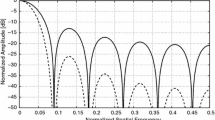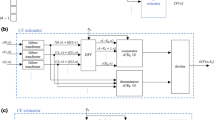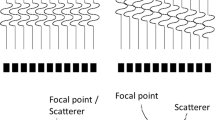Abstract
Purpose
A major limiting factor for applying a minimum variance (MV) beamformer in medical ultrasound imaging is its high computational complexity. This paper introduces a new fast MV beamforming method with almost the same capabilities as the standard MV.
Methods
The fast beamformer is implemented using a cascade structure. At the first stage, the echo signals received from the points far from the main axis are strongly suppressed using a fixed-weight beamformer. At the second stage, after spatially decimating the output of the first stage, an MV-based adaptive beamformer is used to eliminate the echo signals from the points adjacent to the focal point. The greatest advantage of the proposed method is that the second beamformer can be a low-complexity implementation of MV such as beamspace (BS) MV to further reduce the complexity, resulting in a superfast MV.
Results
The resulting beamformers were evaluated through both simulation and experimental data, and it was verified that the method was competitive with standard MV and BS methods at a lower computational cost.
Conclusion
The new fast and superfast MV methods are capable of obtaining the same results as the MV and BS-MV, at a significantly lower computational cost.









Similar content being viewed by others
Notes
Accessible at http://www.k-space.org/temp/Ultrasound/.
References
Synnevag JF, Austeng A, Holm S. Adaptive beamforming applied to medical ultrasound imaging. IEEE Trans Ultrason Ferroelectr Freq Control. 2007;54:1606–13.
Holfort IK, Gran F, Jensen JA. Broadband minimum variance beamforming for ultrasound imaging. IEEE Trans Ultrason Ferroelectr Freq Control. 2009;56:314–25.
Synnevag JF, Austeng A, Holm S. Benefits of minimum-variance beamforming in medical ultrasound imaging. IEEE Trans Ultrason Ferroelectr Freq Control. 2009;56:1868–79.
Asl BM, Mahloojifar A. Eigenspace-based minimum variance beamforming applied to medical ultrasound imaging. IEEE Trans Ultrason Ferroelectr Freq Control. 2010;57:2381–90.
Mehdizade S, Austeng A, Johansen TF, et al. Eigenspace based minimum variance beamforming applied to ultrasound imaging of acoustically hard tissues. IEEE Trans Med Imaging. 2012;31:1912–21.
Hasegawa H. Improvement of penetration of modified amplitude and phase estimation beamformer. J Med Ultrason. 2017;44:3–11.
Hasegawa H. Apodized adaptive beamformer. J Med Ultrason. 2017;44:155–65.
Sakhaei SM, Shamsian SE. Twofold minimum variance beamforming for enhanced ultrasound imaging. J Med Ultrason. 2018;45:17–24.
Nilsen CC, Hafizovic I. Beamspace adaptive beamforming for ultrasound imaging. IEEE Trans Ultrason Ferroelectr Freq Control. 2009;56:2187–97.
Deylami AM, Asl BM. A fast and robust beamspace adaptive beamformer for medical ultrasound imaging. IEEE Trans Ultrason Ferroelectr Freq Control. 2017;64:947–58.
Bae M, Park SB, Kwon SJ. Legendre polynomial based fast minimum variance beamforming method for medical ultrasound systems. Electron Lett. 2014;50:1570–2.
Kim K, Park S, Kim J, et al. A fast minimum variance beamforming method using principal component analysis. IEEE Trans Ultrason Ferroelectr Freq Control. 2014;61:930–45.
Asl BM, Mahloojifar A. A low-complexity adaptive beamformer for ultrasound imaging using structured covariance matrix. IEEE Trans Ultrason Ferroelectr Freq Control. 2012;59:660–7.
Park J, Wi SM, Lee JS. Computationally efficient adaptive beamformer for ultrasound imaging based on QR decomposition. IEEE Trans Ultrason Ferroelectr Freq Control. 2016;63:256–65.
Synnevag JF, Austeng A, Holm S. A low-complexity data-dependent beamformer. IEEE Trans Ultrason Ferroelectr Freq Control. 2011;58:281–9.
Sakhaei SM. A decimated minimum variance beamforming for ultrasound imaging. Ultrasonics. 2015;59:119–27.
Shan TG, Wax M, Kailath T. On spatial smoothing for direction-of-arrival estimation of coherent signals. IEEE Trans Acoust Speech Signal Process. 1985;33:806–11.
Synnevag JF, Austeng A, Holm S. Speckle statistics in adaptive beamforming. In: Proceedings of IEEE Ultrasonics Symposium, 28–31 Oct 2007. IEEE, p. 1545–8.
Jeong MK. A Fourier transform-based sidelobe reduction method in ultrasound imaging. IEEE Trans Ultrason Ferroelectr Freq Control. 2000;47:759–63.
Naidu PS. Sensor array signal processing. CRC Press; 2009.
Jensen JA. Field: a program for simulating ultrasound systems. Med Biol Eng Comput. 1996;34:351–3.
O’Donnell M, Flax SW. Phase-aberration correction using signal from point reflectors and diffuse scatterers: measurements. IEEE Trans Ultrason Ferroelectr Freq Control. 1998;35:768–74.
Krishnan S, Rigby KW, O’Donnell M. Improved estimation of phase aberration profile. IEEE Trans Ultrason Ferroelectr Freq Control. 1997;44:701–13.
Author information
Authors and Affiliations
Corresponding author
Ethics declarations
Conflict of interest
Seyede Elham Shamsian and Sayed Mahmoud Sakhaei declare that they have no conflicts of interest.
Ethical statements
This article does not contain any studies with human or animal subjects performed by either of the authors.
Additional information
Publisher's Note
Springer Nature remains neutral with regard to jurisdictional claims in published maps and institutional affiliations.
About this article
Cite this article
Shamsian, S.E., Sakhaei, S.M. Fast adaptive beamforming through a cascade structure for ultrasound imaging. J Med Ultrasonics 46, 287–296 (2019). https://doi.org/10.1007/s10396-019-00930-w
Received:
Accepted:
Published:
Issue Date:
DOI: https://doi.org/10.1007/s10396-019-00930-w




